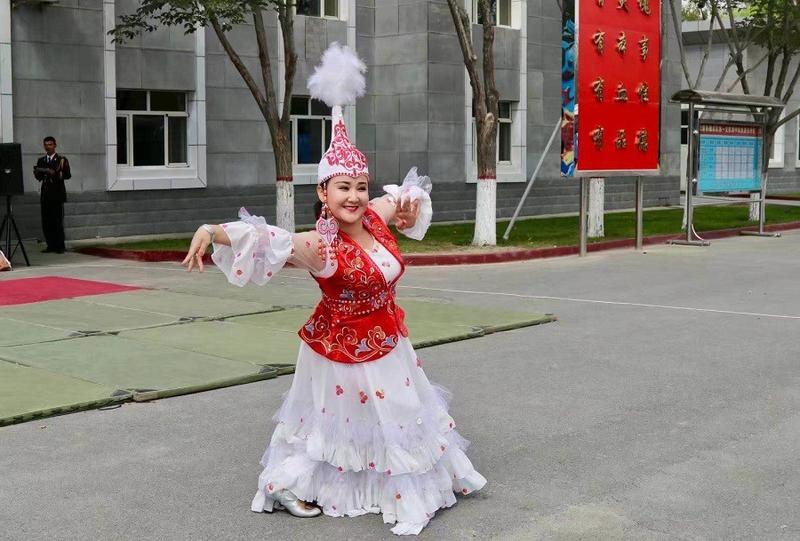 Bahargul Toleheng, a medical worker from the Xinjiang Uygur autonomous region. (PHOTO PROVIDED TO CHINA DAILY)
Bahargul Toleheng, a medical worker from the Xinjiang Uygur autonomous region. (PHOTO PROVIDED TO CHINA DAILY)
Dance lessons, a lending library and psychological counseling are not what you would expect to see in a hospital for patients infected with novel coronavirus pneumonia, which has killed more than 1,600 people on the Chinese mainland.
However, such services have gained increasing popularity among the patients being treated at temporary hospitals in Wuhan, Hubei province, and medical workers and patients said these are just as important as medical treatment in the recovery process.
Bahargul Toleheng, a medical worker from the Xinjiang Uygur autonomous region, became an internet sensation after the video of her teaching dance to patients at a temporary hospital in the Wuhan Parlor exhibition center became very popular on social media.
The patients loved it and had a good laugh. I believe lifting their spirits is a part of the treatment.
Bahargul Toleheng, a medical worker from Xinjiang
ALSO READ: People nationwide come together to help Wuhan
Although she was wearing a protective suit, Bahargul still managed to show the essence of her traditional Uygur and Kazak dances with lively gestures.
"The patients loved it and had a good laugh. I believe lifting their spirits is a part of the treatment," said Bahargul, who is of the Kazak ethnic group.
The medical team from Xinjiang is responsible for 189 patients at the temporary hospital. Bahargul noticed that many patients were very anxious and she wanted to do something to ease their tension.
Since other medical teams have already started to encourage their patients to do some light exercises by leading dance and tai chi classes, she decided to teach them traditional dances from Xinjiang.
As soon as the music started to play, a crowd began to gather. People then started to move their bodies. More importantly, many of them burst into laughter after seeing each other's clumsy moves.
"Laughter is so precious at the hospital as people are away from their families and uncertain about when they can be discharged. All they think about is the disease," Bahargul said.
The regular dance lessons offered by the Xinjiang medical team have become a star event at the hospital and the crowd is getting bigger, she said. Netizens joked that the temporary hospitals are maybe the only places in China that people can still gather and dance together at the moment.
ALSO READ: Innovation helps conquer boredom at home
Like other temporary hospitals, the Wuhan Parlor hospital, which started operation on Feb 7, admits patients who have been confirmed with the infection but show only light symptoms.
They should have no respiratory diseases, be between 18 and 65, and have the ability to care for themselves. The hospital currently houses more than 1,450 patients.
By Saturday, nine such hospitals had been set up in gymnasiums and exhibition centers in Wuhan, epicenter of the epidemic.
We've focused more on offering psychological support for the patients who have been through a lot. We've arranged a series of activities for them such as dance lessons and reading sessions to ease their minds.
Li Zhiqiang, Vice-president of Zhongnan Hospital of Wuhan University who now runs the Wuhan Parlor temporary hospital
Li Zhiqiang, vice-president of Zhongnan Hospital of Wuhan University, now runs the Wuhan Parlor temporary hospital. He said more functions have been gradually added at the temporary hospital to provide better care for the patients.
READ MORE: Officials urge boost in mental health services
Yang Yibing, 41, was among the first 17 patients who had recovered from the novel coronavirus pneumonia at the temporary hospital and was discharged on Saturday. He was also among the first group of the patients that the hospital received.
"The hospital is more like a community. We don't see ourselves as patients but community members," Yang told China Daily over the phone on Sunday. He needs to be isolated for another 14 days at home after being discharged.
At the hospital, his temperature and blood oxygen were checked and recorded three times a day. "People will be immediately transferred to hospitals if their health condition deteriorates. There was nothing to be worried about," Yang said.
Yang enjoyed his daily walk circling the hospital. "There are students doing their homework while some are livestreaming their life at the hospital on social media. We're in this together, and we will win this together."
Yang said the Xinjiang dance classes are his favorite although he's got two left feet.
"It cheers everyone up including the medical team. I was there when Bahargul danced in the white protective suit. She was just like a chubby angel."
Contact the writers at cuijia@chinadaily.com.cn


